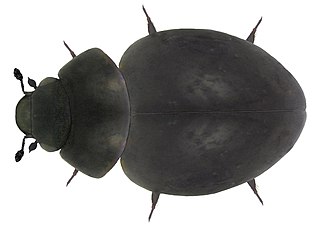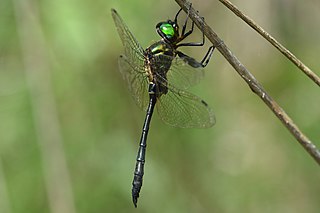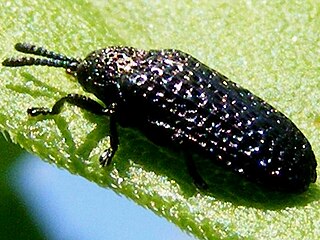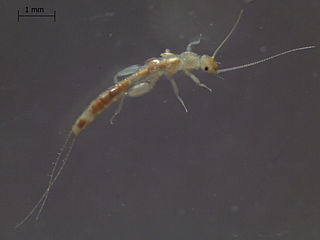
Elgaria is a genus of New World lizards in the family Anguidae. Their common name is western alligator lizards.

Sphaerius is a genus of beetles in the family Sphaeriusidae, comprising 18 species. It is one of the two extant genera in the family, the other being Bezesporum. They are typically found along the edges of streams and rivers, where they feed on algae; they occur on all continents except Antarctica. Three species occur in the United States.

Mantoida is a genus of praying mantises in the family Mantoididae. The species of this genus are native to Mexico, Central America, and South America.

Corduliidae, also knowns as the emeralds, emerald dragonflies, or green-eyed skimmers, is a family of dragonflies. These dragonflies are usually black or dark brown with areas of metallic green or yellow, and most of them have large, emerald-green eyes. The larvae are black, hairy-looking, and usually semiaquatic. This family include species called "baskettails", "emeralds", "sundragons", "shadowdragons", and "boghaunters". They are not uncommon and are found nearly worldwide, but some individual species are quite rare. Hine's emerald dragonfly, for example, is an endangered species in the United States.

Pipunculidae is a family of flies (Diptera) commonly termed big-headed flies, a reference to the large (holoptic) eyes, which cover nearly the entire head. The family is found worldwide and more than 1300 species have been described.

The family Leptoceridae are a family of caddisflies often called "long-horned caddisflies". Leptoceridae is the second largest family of caddisflies with more than 1500 species in around 45 genera. The main identifying feature of most Leptoceridae is that their antennae are longer than those of other caddisflies. There is one genus with short antennae (Ceraclea), but it is easily identified by the pair of dark curved lines on the mesonotum.

Bittacus is a genus of hangingflies in the order Mecoptera. Members of the genus have a cosmopolitan distribution. The genus has existed since at least the earliest Late Cretaceous. Bittacus is considered "grossly paraphyletic" and serves as a catch-all for many distantly related species of hangingflies.

Phymatodes is a genus of beetles in the family Cerambycidae, containing the following species:

Stilbopteryx costalis is a large Australian insect in the antlion family.

Sympherobius is a genus of brown lacewings in the family Hemerobiidae. There are at least 50 described species in Sympherobius.

Pteronarcys is a genus of giant stoneflies in the family Pteronarcyidae. There are about 8 described species in Pteronarcys.

Psectra is a genus of brown lacewings in the family Hemerobiidae. There are more than 20 described species in Psectra.

Apertochrysa is a genus of green lacewings in the family Chrysopidae. There are 183 described species in the genus.

Himalopsyche is a genus of free-living caddisflies in the family Rhyacophilidae. There are more than 40 described species in Himalopsyche.

Microrhopala is a genus of tortoise beetles and hispines in the family Chrysomelidae. There are about 18 described species in Microrhopala.

Zwicknia is a genus of small winter stoneflies in the family Capniidae. There are about 11 described species in Zwicknia.
Isostenosmylus is a genus of neotropical osmylid in the subfamily Stenosmylinae. It has been called "the most species-rich genus of lance lacewings in the Neotropical region."

Ascalaphus is a genus of owlfly belonging to the tribe Ascalaphini. The species of this genus are found in Africa and Asia.

Drepanacra is a genus of lacewings belonging to the family Hemerobiidae.

Chloroperla is a genus of European stone-flies, erected by Edward Newman in 1836; it is the type genus of family Chloroperlidae, subfamily Chloroperlinae and tribe Chloroperlini Okamoto, 1912. Species are distributed in western Palaearctic freshwater habitats: especially Europe and including the British Isles.



















